Overview
The article highlights the vital process at the Department of Veterans Affairs Evidence Intake Center (EIC), which plays a crucial role for veterans seeking disability compensation. We understand that navigating this system can be challenging, and it's essential to know how the EIC manages submissions effectively.
By emphasizing the importance of accurate documentation, we aim to support you in enhancing your chances of success. Additionally, we outline steps for effective communication with the VA, ensuring you feel empowered in your journey toward obtaining benefits.
Remember, you are not alone in this process; we’re here to help you every step of the way.
Introduction
Navigating the complexities of the Department of Veterans Affairs can feel overwhelming for many former service members. We understand that understanding the role of the Evidence Intake Center (EIC) in Janesville, Wisconsin, is crucial. This specialized facility plays a vital role in streamlining the submission and processing of documentation related to disability compensation claims. Our goal is to ensure that veterans receive the benefits they deserve in a timely manner.
However, it’s common to feel lost in the submission process or frustrated when communication with the VA falters. This article will guide you through essential steps for effectively engaging with the EIC. We’ll address common challenges and highlight the importance of proactive communication throughout your claims journey. Remember, you are not alone in this process, and we’re here to help you every step of the way.
Define the VA Evidence Intake Center and Its Role
The specialized facility known as the department of veteran affairs evidence intake center (EIC) is located in Janesville, Wisconsin, and operates within the Department of Veterans Affairs. It is dedicated to receiving, processing, and managing evidence submitted by service members and their representatives. We understand that navigating the benefits system can be overwhelming. The EIC's main purpose is to ensure that all relevant documentation is gathered and organized effectively to assist with requests for benefits. This center plays a crucial role in speeding up the process, facilitating better communication between former service members and the VA, ultimately leading to quicker resolutions of requests.
The EIC focuses solely on disability compensation requests, which is vital for former service members seeking timely responses. It's important to note that documents submitted through the EIC are marked with the date they are received, not the mailing date. This distinction can significantly affect deadlines and the overall processing schedule.
Moreover, the EIC employs modern tools like QuickSubmit, allowing experienced individuals to upload documents digitally. This innovation reduces the risk of delays that often accompany traditional mailing methods. By embracing this digital approach, service members can expect prompt replies regarding their requests.
Expert insights highlight the EIC's significance in the compensation process. Many former service members have shared that understanding how to interact with the EIC has been essential in securing their benefits. For instance, those who have faced challenges with their submissions often find that presenting their documentation appropriately through the EIC leads to better outcomes. With information suggesting that 80% of former service members may feel undervalued by the VA, the role of the EIC in facilitating accurate and timely submissions cannot be overstated.
In conclusion, the claims process is vital to the department of veteran affairs evidence intake center. It provides service members with a streamlined path to present documentation and receive decisions on their claims more effectively. By utilizing the resources and support available through the EIC, veterans can improve their chances of successfully navigating the complex benefits system. Remember, you're not alone in this journey—we're here to help.
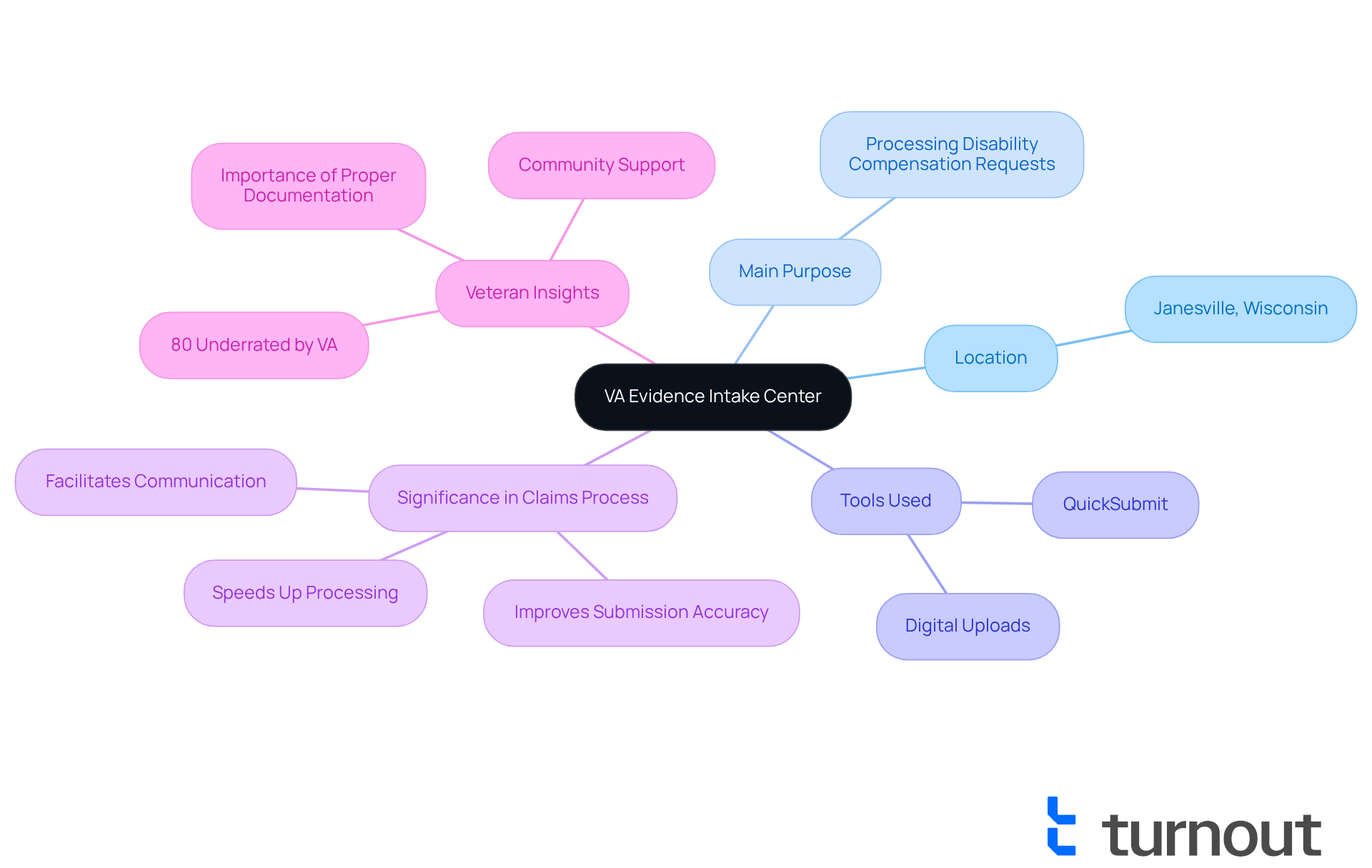
Explain the Evidence Submission Process
Navigating the evidence submission process at the department of veteran affairs evidence intake center can feel overwhelming, but we are here to guide you through it with care. Here are several key steps to help you along the way:
-
Gather Required Documentation: Start by collecting all necessary documents that substantiate your request, such as medical records, service records, and any other relevant evidence. This foundational step is crucial for a successful assertion.
-
Complete the VA Form 21-526EZ: This form is essential for submitting a request for disability compensation. Make sure all sections are filled out accurately to avoid delays in processing.
-
Consider the Fully Developed Claim (FDC) Program: If you have all your documentation prepared, consider utilizing the FDC program. It allows for accelerated processing of your claim, which can significantly reduce the time it takes for the VA to review your submission.
-
Submit Documentation: You can submit your documentation online through the VA's website, via mail, or in person at a VA regional office. Ensure that all documents are clearly labeled and organized to facilitate review.
-
Work with Accredited Veterans Service Organization (VSO) Representatives: Collaborating with a VSO can enhance your claims process. They can assist in collecting essential medical documents and evidence, ensuring that your application is as robust as possible.
-
Track Your Submission: After submission, keep a record of your documents and any confirmation received from the VA. This will help you follow up if needed and ensure that your request is being processed.
By following these steps, former service members can ensure that their documentation is submitted accurately and effectively to the department of veteran affairs evidence intake center, which promotes a more seamless application process. Many veterans have shared their experiences, highlighting how structured and complete entries greatly enhanced their outcomes. On average, processing times for VA Form 21-526EZ entries can vary, typically ranging from a few weeks to several months. Remaining proactive in monitoring your entry can help reduce delays.
Additionally, submitting an Intent to File can set an effective date for your request, giving you time to collect information while safeguarding your possible benefits. Remember, you are not alone in this journey, and we are here to help you every step of the way.
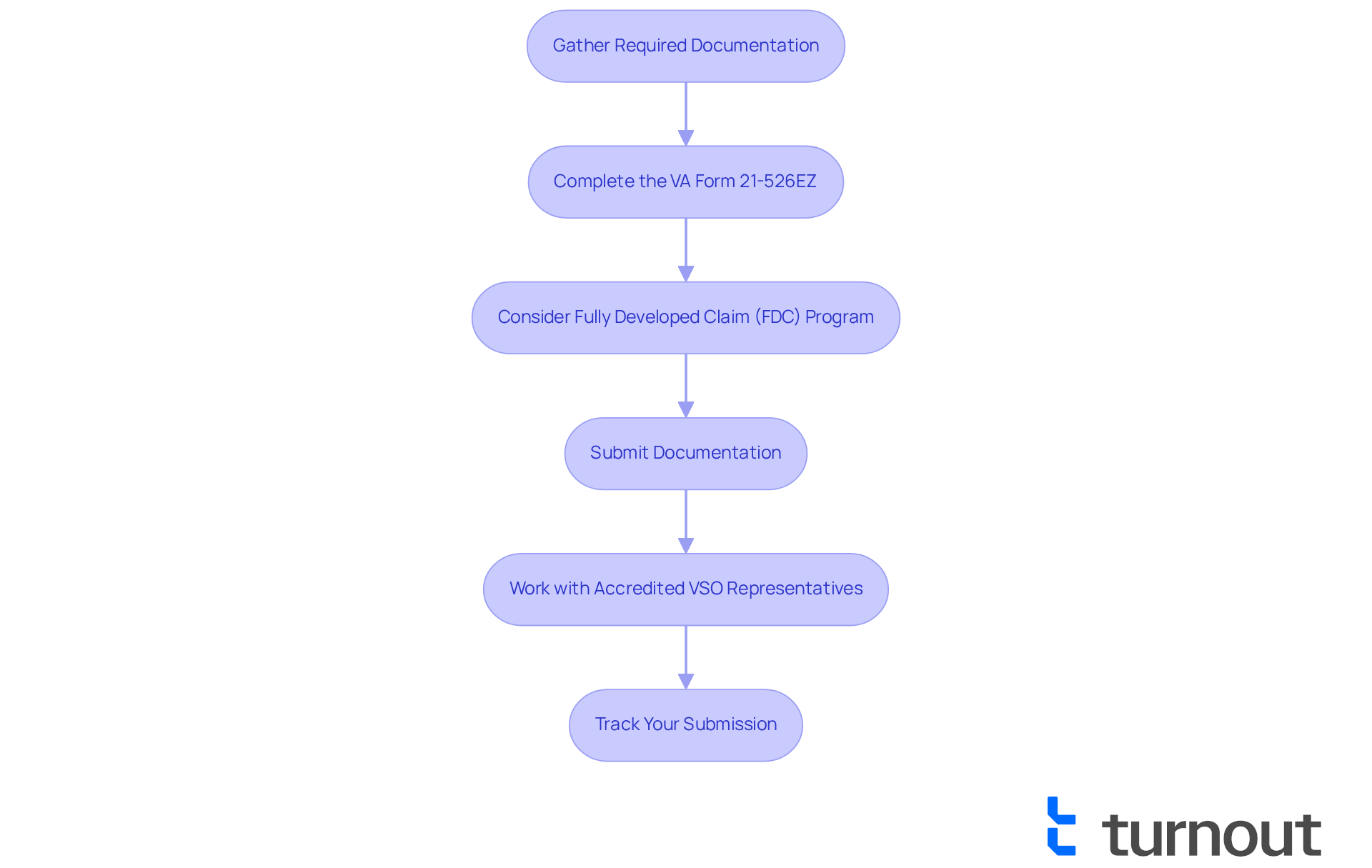
Identify Reasons for VA Communication
The VA may reach out to veterans for several reasons during the claims process, and understanding these reasons can help ease some of the stress involved.
-
Request for Additional Information: If the initial submission lacks necessary details or documentation, the VA will request further evidence to support the claim. We understand that this can be frustrating. One veteran noted, 'I submitted everything they asked for, yet they still wanted more.' Typical requests might encompass medical records, service documents, or supplementary statements to clarify the matter.
-
Clarification of Submitted Evidence: Sometimes, the VA may need clarification on specific documents or statements included in the submission. This can lead to delays, and it's common to feel overwhelmed when trying to understand what additional information is required. Turnout's trained nonlawyer advocates can assist in this area by providing guidance on how to effectively communicate with the VA and what documentation may be necessary.
-
Notification of Status: The VA will communicate updates regarding the status of the request, including any decisions made or additional steps required. Veterans have shared varied experiences regarding this communication; one said, 'I felt entirely uninformed about my situation until I finally received an update.' Many former service members report waiting weeks or even months for a response, which can heighten stress during an already challenging process. Turnout seeks to streamline this experience by providing resources and professional advice to help service members stay updated on their claims.
-
Scheduling Examinations: In certain instances, the VA may require individuals with military service to undergo medical examinations to evaluate the severity of their conditions. This step is crucial for determining eligibility and benefits but can add to the overall wait time. For instance, Joe shared his experience of waiting three years for an appeal decision, highlighting the emotional impact of such delays. Turnout's trained non-legal advocates can assist military personnel in navigating these requirements and ensure they are prepared for any necessary evaluations.
By grasping these possible communications, former service members can prepare and respond efficiently, ensuring their requests progress without unnecessary holdups. The typical wait duration for a service member's claim to be processed has reduced from 141.5 days to 131.8 days, yet many individuals still face considerable challenges navigating the online claims submission system. With Turnout's support, veterans can better manage these complexities and access the benefits they deserve. Remember, you are not alone in this journey; we're here to help.
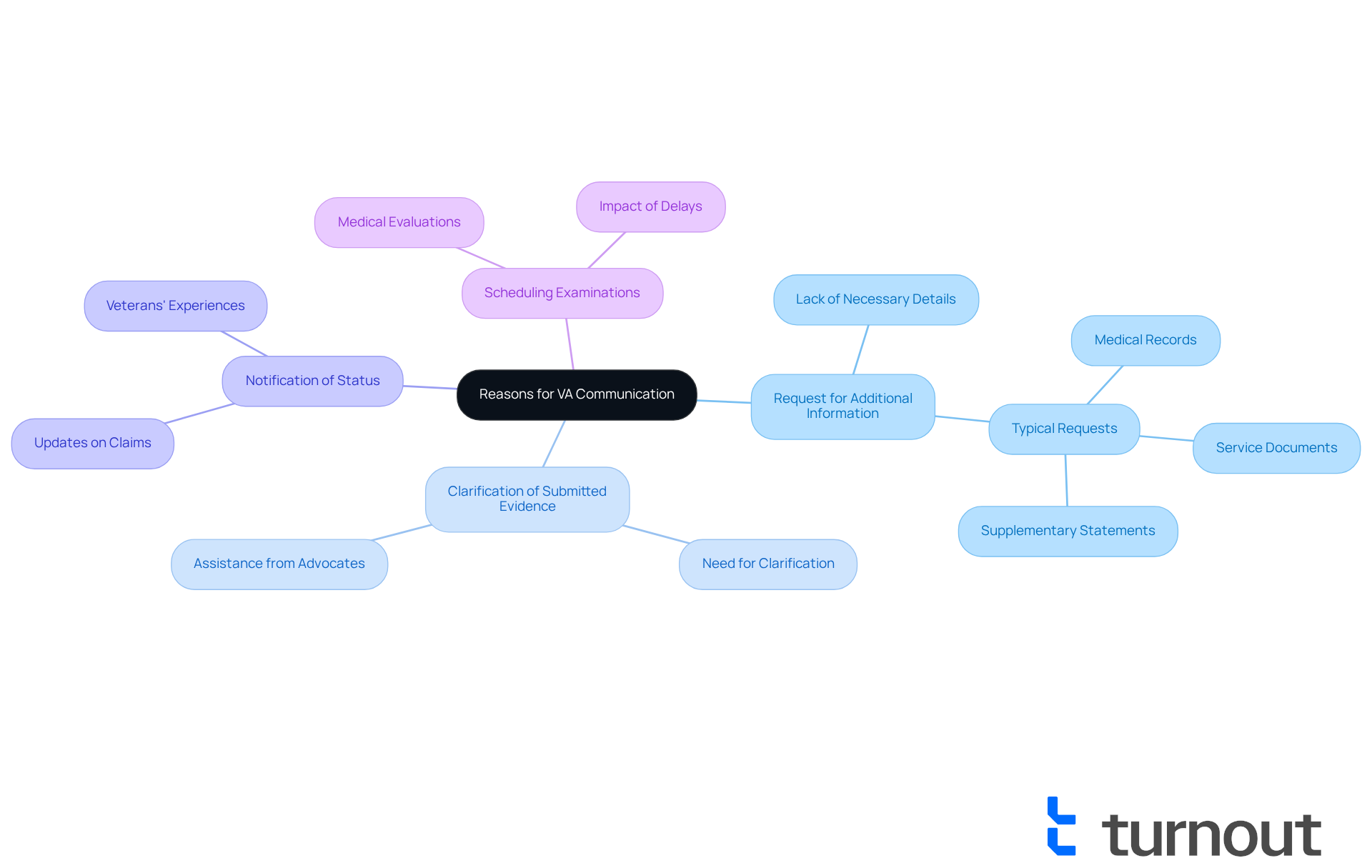
Guide on Responding to VA Letters
When responding to VA letters, it's important to follow these caring guidelines:
-
Read the Letter Carefully: We understand that receiving a letter from the VA can be overwhelming. Take the time to fully grasp the request or information provided. Pay close attention to any deadlines and specific requirements outlined in the letter.
-
Gather Necessary Information: Collect all documents or evidence requested. Ensure that the information is accurate and relevant to your assertion. You are not alone in this process, and gathering the right materials can make a significant difference.
-
Draft a Clear Response: Address the points raised in the letter directly. Be concise and organize your response to include all the requested information. Remember, clarity is key, and your voice deserves to be heard.
-
Submit Your Response Promptly: Send your response as soon as possible, adhering to any deadlines specified. Utilizing certified mail or a secure online submission method can help confirm receipt, giving you peace of mind.
-
Keep Copies: Maintain copies of all correspondence for your records. This will be beneficial for future reference or if any issues arise. Keeping track of your communications is an important step in managing your journey.
By following these steps, veterans can successfully engage with the VA, ensuring their requests stay on course. Timely responses are essential; statistics indicate that submissions handled with prompt communication have significantly higher success rates. For instance, the VBA's national accuracy rate shows that prompt responses can lead to better outcomes in processing requests. As one experienced individual remarked, "I discovered that being proactive with my responses significantly impacted the success of my application." This proactive strategy not only aids in navigating the complexities of the VA system but also empowers service members to take charge of their applications. Remember, we're here to help you every step of the way.
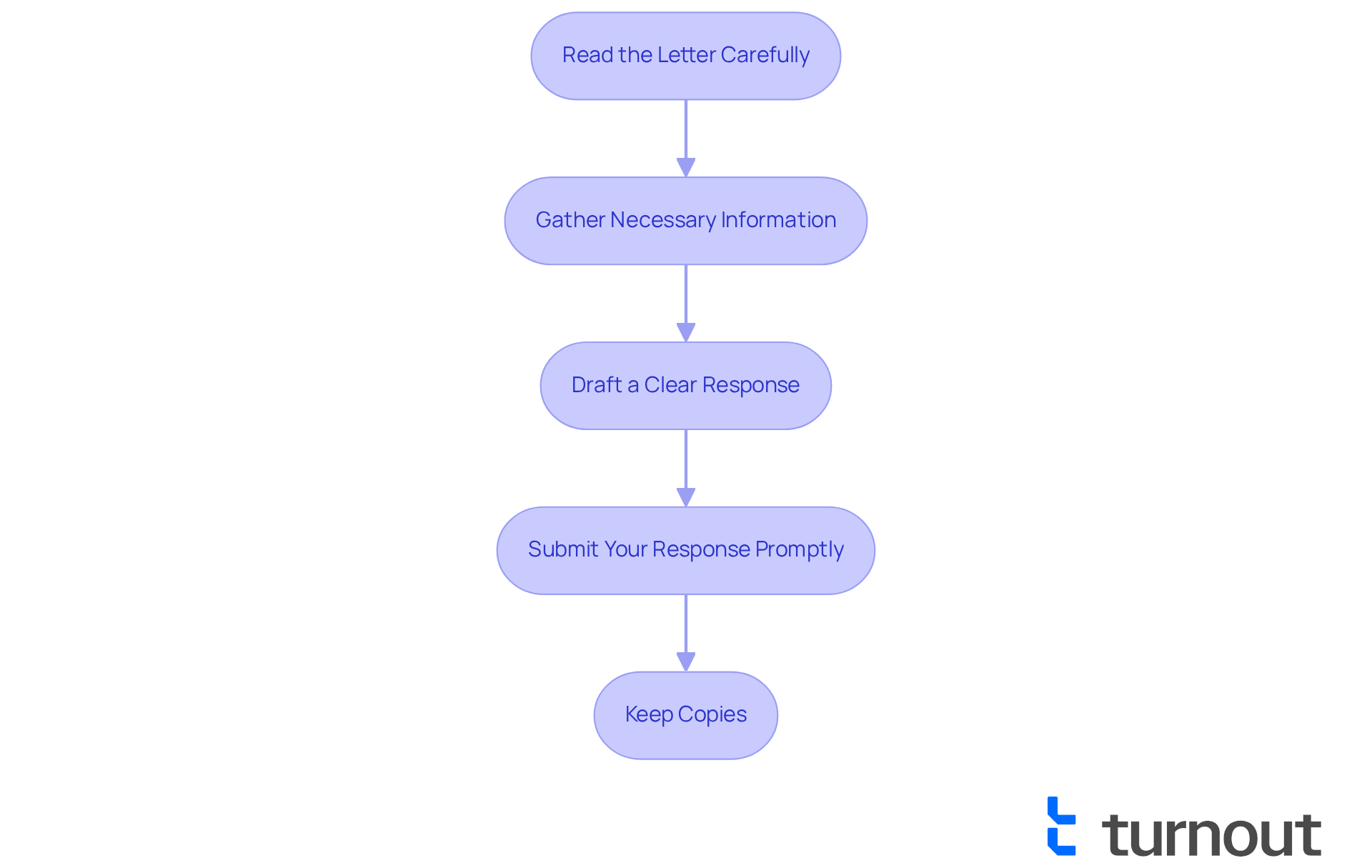
Highlight the Importance of Ongoing Communication
Ongoing communication with the VA is essential for several reasons:
- Stay Informed: Regularly checking the status of your claim keeps you updated on any developments or requirements, ensuring you are aware of what is needed at each stage.
- Address Issues Promptly: Timely communication allows you to tackle any problems that arise, such as missing documentation or delays, before they escalate into larger issues.
- Build a Relationship: Establishing a rapport with VA representatives can lead to smoother interactions and potentially more favorable outcomes, as familiarity can foster trust and understanding.
- Clarify Expectations: Regular communication aids in defining what to anticipate at each phase of the process, alleviating stress and doubt for service members.
Turnout offers resources and services aimed at making it easier to access government benefits, including support with SSD requests. By employing skilled nonlegal advocates, Turnout assists former military personnel in sustaining consistent communication with the VA. These supporters help by offering advice on essential paperwork, following up on requests, and resolving any problems that may occur during the process.
Data shows that veterans who keep regular contact with the VA achieve higher approval rates for their requests. For example, almost two-thirds of denied requests are recoverable, frequently because of proactive follow-ups and clarifications. Veterans have expressed that effective communication greatly influences their experience with requests. One experienced individual remarked, 'I discovered that maintaining communication with my representative significantly impacted how my claim was processed.'
By prioritizing ongoing communication and leveraging Turnout's expert guidance, veterans can navigate the VA system more effectively, enhancing their chances of receiving the benefits they deserve. Remember, you are not alone in this journey; we’re here to help you every step of the way.
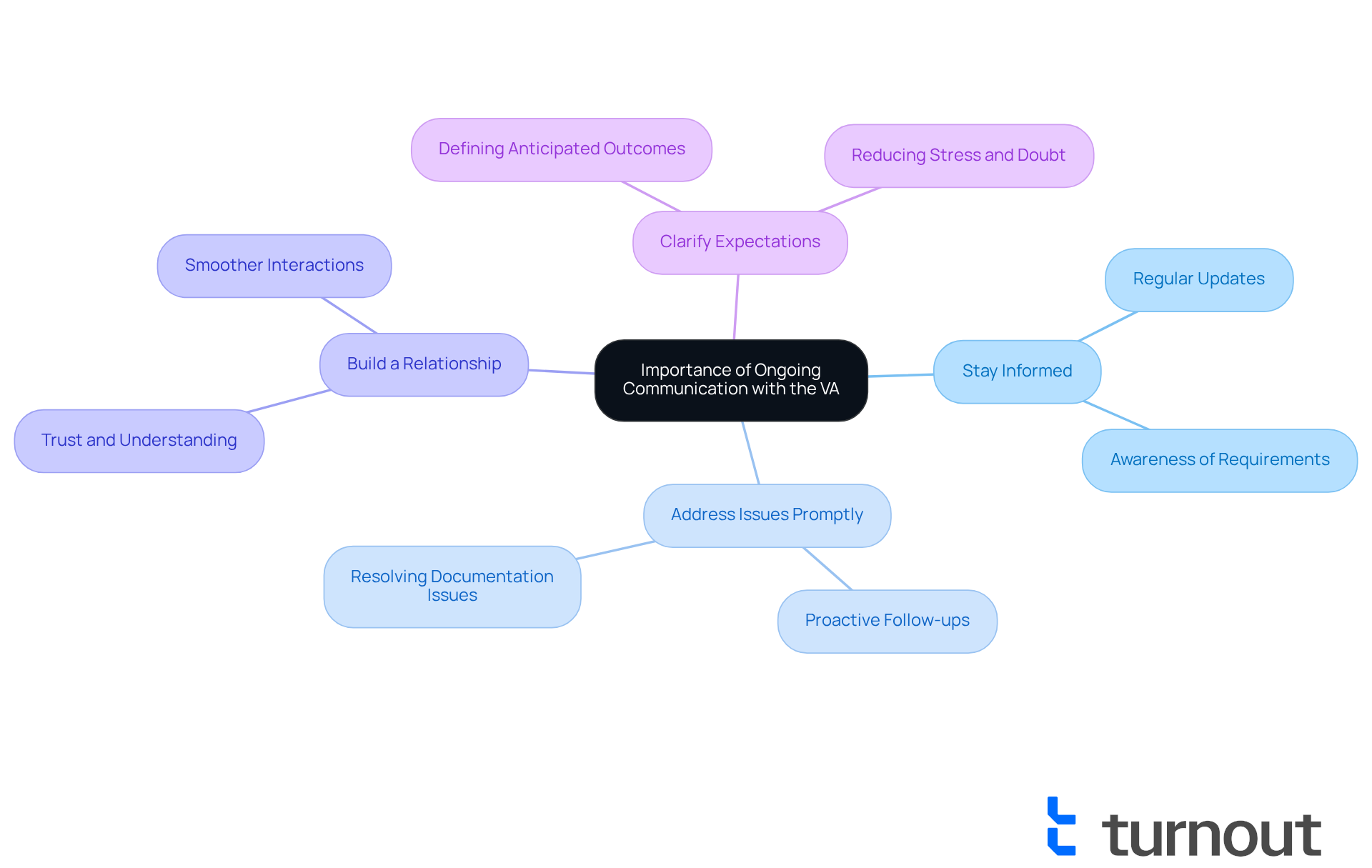
Conclusion
The Department of Veteran Affairs Evidence Intake Center (EIC) stands as a crucial ally for former service members navigating the often overwhelming benefits system. By simplifying the submission and processing of evidence, the EIC fosters better communication between veterans and the VA, leading to quicker resolutions of disability compensation claims. Understanding the EIC's role is essential for veterans who wish to secure their rightful benefits in a timely manner.
Throughout this article, we explored key aspects of the EIC's functions, such as:
- The importance of gathering necessary documentation
- Utilizing digital submission tools
- Maintaining proactive communication with the VA
We highlighted essential strategies for improving the claims process, including:
- Steps for submitting evidence
- Responding to VA letters
- The significance of ongoing communication
Many veterans have shared their experiences, underscoring that a well-organized submission and timely responses can dramatically impact the outcome of their claims.
In light of these insights, it's clear that veterans must take an active role in their claims journey. By leveraging the resources available through the EIC and maintaining consistent communication with VA representatives, former service members can navigate the complexities of the benefits system more effectively. Remember, empowerment through knowledge and a proactive approach not only boosts the likelihood of successful claims but also strengthens the support network available for veterans. You are not alone in this journey, and we are here to help.
Frequently Asked Questions
What is the VA Evidence Intake Center (EIC) and what is its role?
The VA Evidence Intake Center (EIC) is a specialized facility located in Janesville, Wisconsin, that operates within the Department of Veterans Affairs. Its primary role is to receive, process, and manage evidence submitted by service members and their representatives, focusing specifically on disability compensation requests. The EIC aims to streamline the benefits process and improve communication between former service members and the VA for quicker resolutions.
How does the EIC affect the processing of disability compensation requests?
The EIC plays a crucial role in speeding up the processing of disability compensation requests by ensuring that all relevant documentation is gathered and organized effectively. Documents submitted through the EIC are marked with the date they are received, which can impact deadlines and processing schedules.
What tools does the EIC use to facilitate document submission?
The EIC employs modern tools like QuickSubmit, which allows individuals to upload documents digitally. This approach reduces the risk of delays associated with traditional mailing methods, enabling service members to receive prompt replies regarding their requests.
What steps should be followed to submit evidence to the EIC?
To submit evidence to the EIC, follow these steps: 1. Gather required documentation (e.g., medical and service records). 2. Complete the VA Form 21-526EZ accurately. 3. Consider utilizing the Fully Developed Claim (FDC) Program for accelerated processing. 4. Submit documentation online, via mail, or in person at a VA regional office, ensuring documents are clearly labeled. 5. Work with Accredited Veterans Service Organization (VSO) Representatives for assistance. 6. Track your submission and keep a record of documents and confirmations received.
What is the Fully Developed Claim (FDC) Program?
The Fully Developed Claim (FDC) Program is an option available to veterans who have all necessary documentation prepared. It allows for accelerated processing of claims, which can significantly reduce the time it takes for the VA to review submissions.
How can veterans track their submissions to the EIC?
Veterans can track their submissions by keeping a record of all documents submitted and any confirmation received from the VA. This helps in following up if needed and ensures that the request is being processed.
What is the average processing time for VA Form 21-526EZ entries?
The processing times for VA Form 21-526EZ entries can vary, typically ranging from a few weeks to several months. Remaining proactive in monitoring the submission can help reduce delays.
What is an Intent to File and how does it help veterans?
An Intent to File is a submission that can set an effective date for a veteran's request for benefits. It allows veterans time to collect necessary information while safeguarding their potential benefits.
How can veterans improve their chances of successfully navigating the benefits system through the EIC?
Veterans can improve their chances by ensuring their documentation is complete and accurately submitted, utilizing resources and support available through the EIC, and collaborating with accredited representatives to enhance their claims process.




